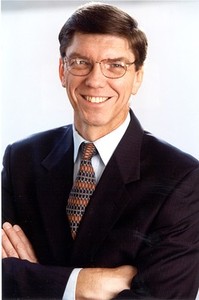“Clayton M. Christensen” Source of caption and photo: online version of the WSJ interview quoted and cited below.
(p. R2) BUSINESS INSIGHT: . . . There must be, . . . , cases where concerns about the market cause companies to abandon their plans for new products or really retrench. Or do you see that happening less these days as companies realize the importance of keeping up with changing markets?
DR. CHRISTENSEN: In the next two years, I think the answer will hinge quite a bit on the role that hedge funds play in driving stock prices. By now, 95% of all trades on the stock exchange are executed by hedge funds, mutual funds or pension funds that you could not call shareholders. They’re share owners, but they don’t even hold the shares long enough, on average, to vote the proxy. And long-term shareholders are always better for innovation than the short-term people are.
BUSINESS INSIGHT: So we might see innovation more from private companies?
DR. CHRISTENSEN: Absolutely right. And there’s another business model toward which more and more companies need to move. It’s a business model you see with Li & Fung in Hong Kong, Tata Sons in India, and Cox Enterprises in Atlanta. In this model, the holding company is privately held, and then certain of the subsidiary companies that have the right characteristics take their shares public on the market.
What that allows those companies to do is, when they have a disruptive innovation that they need to launch, they can just do it under the private umbrella of the holding company, and not have it reduce the near-term performance of the publicly held subsidiaries.
For the full interview, see:
Martha E. Mangelsdorf, interviewer. “Executive Briefing; How Hard Times Can Drive Innovation.” Wall Street Journal (Mon., DECEMBER 15, 2008): R2.
(Note: ellipses added.)

